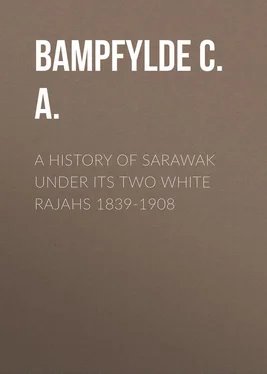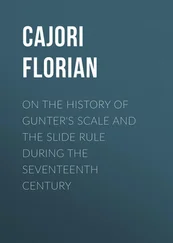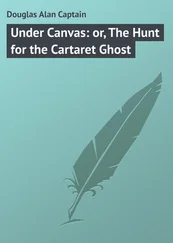C. Bampfylde - A History of Sarawak under Its Two White Rajahs 1839-1908
Здесь есть возможность читать онлайн «C. Bampfylde - A History of Sarawak under Its Two White Rajahs 1839-1908» — ознакомительный отрывок электронной книги совершенно бесплатно, а после прочтения отрывка купить полную версию. В некоторых случаях можно слушать аудио, скачать через торрент в формате fb2 и присутствует краткое содержание. ISBN: , Жанр: foreign_antique, foreign_prose, на английском языке. Описание произведения, (предисловие) а так же отзывы посетителей доступны на портале библиотеки ЛибКат.
- Название:A History of Sarawak under Its Two White Rajahs 1839-1908
- Автор:
- Жанр:
- Год:неизвестен
- ISBN:http://www.gutenberg.org/ebooks/52873
- Рейтинг книги:4 / 5. Голосов: 1
-
Избранное:Добавить в избранное
- Отзывы:
-
Ваша оценка:
- 80
- 1
- 2
- 3
- 4
- 5
A History of Sarawak under Its Two White Rajahs 1839-1908: краткое содержание, описание и аннотация
Предлагаем к чтению аннотацию, описание, краткое содержание или предисловие (зависит от того, что написал сам автор книги «A History of Sarawak under Its Two White Rajahs 1839-1908»). Если вы не нашли необходимую информацию о книге — напишите в комментариях, мы постараемся отыскать её.
A History of Sarawak under Its Two White Rajahs 1839-1908 — читать онлайн ознакомительный отрывок
Ниже представлен текст книги, разбитый по страницам. Система сохранения места последней прочитанной страницы, позволяет с удобством читать онлайн бесплатно книгу «A History of Sarawak under Its Two White Rajahs 1839-1908», без необходимости каждый раз заново искать на чём Вы остановились. Поставьте закладку, и сможете в любой момент перейти на страницу, на которой закончили чтение.
Интервал:
Закладка:
The Sea-Dayaks have many good qualities that are more or less lacking in the other inland tribes. They are industrious, honest and thrifty, sober and cheerful, and comparatively moral. But the characteristics that mainly distinguish them are energy and independence. They are exceedingly sensitive, especially the women, and will seek refuge from shame in suicide; 30 30 Disappointment in marriage and unkindness or harshness on the part of relatives are common causes of suicide by man or woman, but the most common motive is shame, particularly in cases of an unmarried woman, when enceinte , being unable to prove to the tribe who the father of her child is. A whole family has been known to poison themselves to escape the consequences and disgrace which would have befallen them owing to one of them having been the accidental cause of a long communal house being destroyed by fire. Suicide is invariably committed by eating the poisonous root of the tuba plant, derris elliptica .
like the Malays the men will sometimes, though not often, amok when suffering from depression caused by grief, shame, or jealousy, for in the East this peculiar form of insanity is by no means confined to the Malay as is popularly supposed. 31 31 The worst on record in Sarawak was committed in 1894 by a half-bred Chinaman (his mother was a Segalang, and he was brought up as one) at Seduan village, three miles from Sibu, in the Rejang. This man, who had just been discharged from jail, arose in the middle of the night, and speared or cut down all the inmates of the house – thirteen women and children, of whom only two or three survived. He was shot by Mr. Q. A. Buck, then the Resident at Sibu (joined 1874, retired 1899), who was quickly on the spot, and was the means of preventing a further loss of life.
Amongst them general social equality exists, and it is extended to their women. They do not suffer their chiefs to abuse their powers as the Kayan and Kenyah chiefs are allowed to do, but they are quite ready to submit to them when justness and uprightness is shown. They are superstitious and restless, and require a firm hand over them, and, "being like truant children, take a great advantage of kindness and forbearance, and become more rebellious if threats are not carried into execution." This was the advice given by the present Rajah to the Netherland officials some years ago. Their inherited desire for human skulls, and their old savage methods of obtaining them, still, in a degree, have a strong hold on the Sea-Dayak character, but against this it can be said to their credit that they are free from cruelty, and never torture a captive as do the Kayans and other tribes. They are kindly to their captives, and treat them as members of the family; and they were a peaceable people before they were led astray by the half-bred Arabs and the Malays.
The Sea-Dayaks are the collectors of jungle produce, in search of which they go on expeditions far into the interior – to Sumatra, the Malayan States, and North Borneo – and are away for months at a time.
The Dayak custom of head-hunting is founded on the same principle as that of scalp-hunting among the North-American Indians. A young man formerly found it difficult to obtain a wife till he had got at least one head to present to the object of his heart as token of his prowess; but it was quite immaterial whether the head was that of man or woman, of old or young. If a Dayak had lost a near relative it became his duty to obtain a head, for until this was accomplished, and a head feast had been given, the family must remain in mourning, and the departed relative would have no attendant in Sembayan (the shades); and so in the event of a chief dying it was incumbent upon the warriors of the tribe to procure one or more heads, in order that his spirit should be properly attended by the spirits of those sacrificed in his honour. Thus head-hunting became more or less a natural instinct, and an obligatory duty.
The ancient Chinese jars, 32 32 The Sea-Dayaks say that they were constructed by the gods when they made the sky, out of a small surplus of the blue.
held in great esteem among the natives, and very highly prized, being supposed to be possessed of supernatural powers and healing virtues, 33 33 St. John, op. cit. , mentions that the late Sultan Mumin of Bruni had an ancient jar which was reputed to be able to speak, and that it moaned sorrowfully the night before his first wife died. He refused £2000 for it.
are of various kinds and value. The Gusi is the most valued, and is treated with great care and veneration, and stands about eighteen inches high. Then comes the Lingka, then the Benaga, 34 34 Naga , a dragon; benaga , having a dragon.
about two feet high, ornamented with the Chinese dragon. The Rusa 35 35 Meaning a deer in Malay and Sea-Dayak.
is the least valued. From a note made in 1890 these are the lowest prices they fetch – Gusi tuak, $1000; Gusi bulan, $700; Gusi chendanum, $500; Galagiau, $400; Lingka, $310; Rusa, $150, In 1890 $7 = £1. These jars are all brown in colour. The Dayaks and Kayans possess a few fine blue and white, and pink and white, old Chinese jars, some over five feet in height.
About forty years ago an enterprising Chinese petty dealer took samples of the jars to China and had clever imitations made. He realised a large sum by the sale, and started as a merchant on a large scale, grew rich, waxed fat, and became the leading and wealthiest Chinese merchant in Kuching. The Malays are clever in "faking" jars, especially such as are cracked, but the Dayaks are not now to be deceived by them.
The Dayak village, like those of all interior tribes, is a communal establishment. It does not consist of separate huts occupied by any one family, but of large common halls on platforms, sometimes 800 ft. long, upon which the dwelling-rooms abut. They are constructed of wood, and are supported on poles sometimes 20 ft. to 40 ft. above the ground, the poles being from 6 to 18 inches in diameter. The largest will contain some 300 people. The following is a description of the Dayak village of Tunggang from the late Rajah's journal: —
Tunyang 36 36 A misprint for "Tunggang."
stands on the left hand (going up) close to the margin of the stream, and was enclosed by a slight stockade. Within this defence there was one enormous house for the whole population. The exterior of the defence between it and the river was occupied by sheds for prahus (boats), and at each extremity were one or two houses belonging to Malay residents.
The common habitation, as rude as it is enormous, measures 594 ft. in length, and the front room or street is the entire length of the building, and 21 feet broad. The back part is divided by mat partitions into the private apartments of the various families, and of these there are forty-five separate doors leading from the public apartment. The widowers and the young unmarried men occupy the public room, as only those with wives are entitled to the advantage of a separate room. The floor of the edifice is raised twelve feet from the ground, and the means of ascent is by the trunk of a tree with notches cut in it – a most difficult, steep, and awkward ladder. In front is a terrace fifty feet broad, running partially along the front of the building, formed like the floors, of split bamboo. This platform, as well as the front room, besides the regular inhabitants, is the resort of dogs, birds, monkeys, and fowls, and presents a glorious scene of confusion and bustle. Here the ordinary occupations of domestic labour are carried on. There were 200 men, women, and children counted in the room, and in front, whilst we were there in the middle of the day; and allowing for those who were abroad, or then in their own rooms, the whole community cannot be reckoned at less than 400 souls. The apartment of their chief is situated nearly in the centre of the building, and is larger than any other. In front of it nice mats were spread on the occasion of our visit, whilst over our heads dangled about thirty ghastly skulls, according to the custom of these people.
Читать дальшеИнтервал:
Закладка:
Похожие книги на «A History of Sarawak under Its Two White Rajahs 1839-1908»
Представляем Вашему вниманию похожие книги на «A History of Sarawak under Its Two White Rajahs 1839-1908» списком для выбора. Мы отобрали схожую по названию и смыслу литературу в надежде предоставить читателям больше вариантов отыскать новые, интересные, ещё непрочитанные произведения.
Обсуждение, отзывы о книге «A History of Sarawak under Its Two White Rajahs 1839-1908» и просто собственные мнения читателей. Оставьте ваши комментарии, напишите, что Вы думаете о произведении, его смысле или главных героях. Укажите что конкретно понравилось, а что нет, и почему Вы так считаете.












